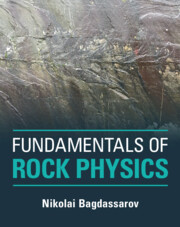Book contents
- Fundamentals of Rock Physics
- Fundamentals of Rock Physics
- Copyright page
- Dedication
- Contents
- Preface
- 1 Introduction
- 2 Density and Porosity
- 3 Stresses in Rocks
- 4 Mechanical Strain and Elastic Moduli
- 5 Permeability of Rocks
- 6 Mechanical Properties of Fluid-Bearing Rocks
- 7 Acoustic Properties of Rocks
- 8 Electric Resistivity
- 9 Dielectric Properties
- 10 Magnetic Properties of Rocks
- 11 Thermal Properties of Rocks and Minerals
- 12 Radioactive Properties of Rocks
- Index
- References
11 - Thermal Properties of Rocks and Minerals
Published online by Cambridge University Press: 19 November 2021
- Fundamentals of Rock Physics
- Fundamentals of Rock Physics
- Copyright page
- Dedication
- Contents
- Preface
- 1 Introduction
- 2 Density and Porosity
- 3 Stresses in Rocks
- 4 Mechanical Strain and Elastic Moduli
- 5 Permeability of Rocks
- 6 Mechanical Properties of Fluid-Bearing Rocks
- 7 Acoustic Properties of Rocks
- 8 Electric Resistivity
- 9 Dielectric Properties
- 10 Magnetic Properties of Rocks
- 11 Thermal Properties of Rocks and Minerals
- 12 Radioactive Properties of Rocks
- Index
- References
Summary
Conduction of thermal energy according to Fourier’s law is the principal mechanism of heat transport in rocks, which is due to movement of electrons (electron conduction) and by lattice atoms (phonon or lattice conduction). Heat capacity of minerals at low temperature is mostly due to lattice contributions. At high temperatures, electron heat capacity and thermal conductivity are significant. Pressure dependence of thermal conductivity is described by the Bridgman equation. Pressure derivative is scaled to the Bridgman parameter. For thermal conductivity of cubic crystals above Debye temperature, Slack’s formula is used. The Wiedemann–Franz law relates thermal conductivity (?) and electrical conductivity. Increased concentration of vacancies reduces thermal conductivity, but it increases with tilt angle of grain boundaries. To measure thermal conductivity, Forbes, Ångström, Kohlrausch, and flash diffusivity methods are used. Phase transition and melting/crystallization affect heat capacity and thermal conductivity. Geothermal energy is connected with the properties of fluid-saturated rocks. Focus Box 11.1: Phonons and Debye temperature. Focus Box 11.2: Grüneisen parameter.
Keywords
- Type
- Chapter
- Information
- Fundamentals of Rock Physics , pp. 455 - 504Publisher: Cambridge University PressPrint publication year: 2021

